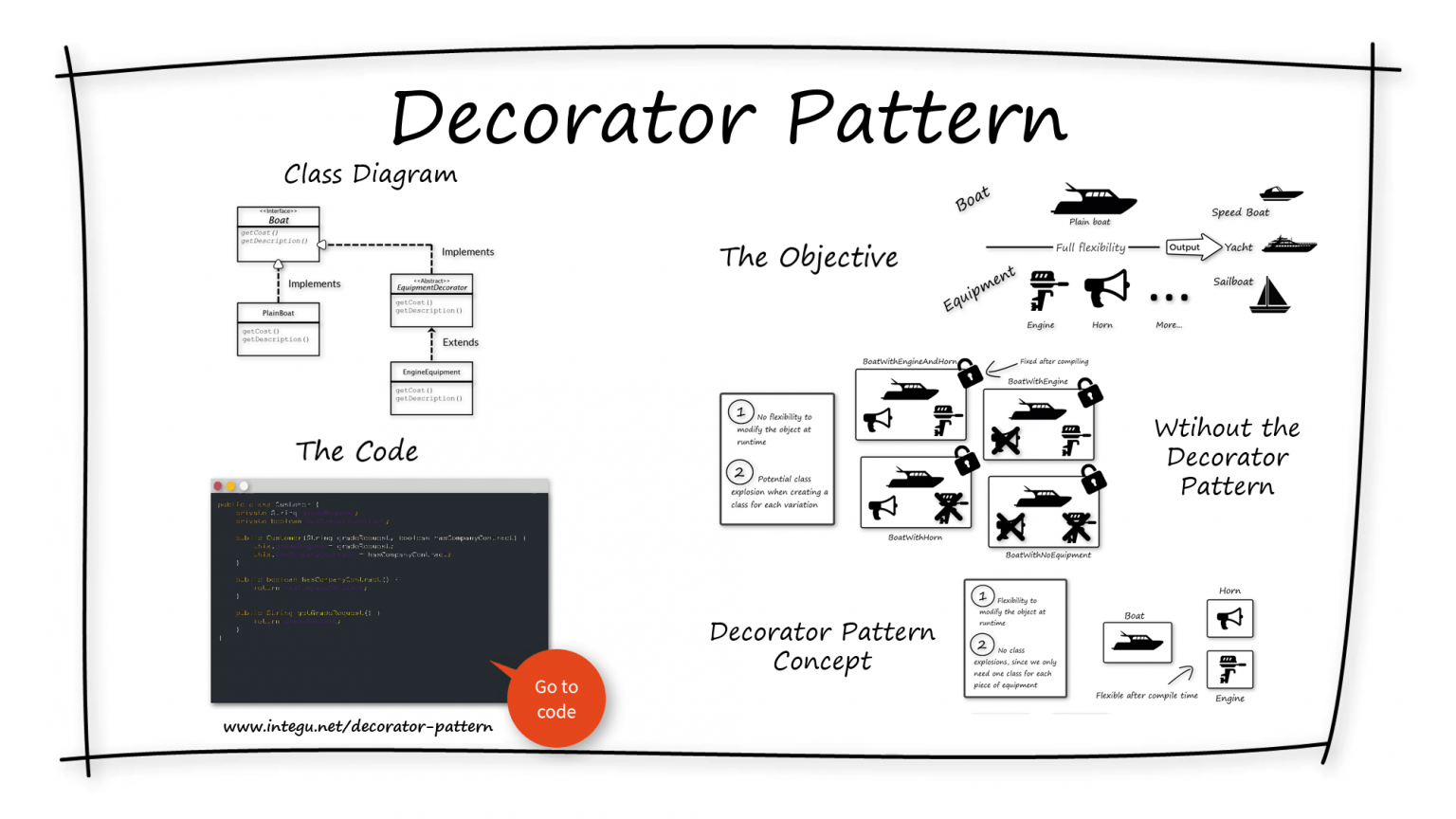Decorator Pattern: Enhancing Designs Simplified

In the world of software development, design patterns are pivotal for creating flexible, reusable, and maintainable code. One such pattern, the Decorator Pattern, stands out for its elegance and utility in extending object behavior at runtime. This pattern allows developers to add new functionalities to objects without altering their underlying structure, promoting the principles of open-closed design where classes are open for extension but closed for modification.
Understanding the Decorator Pattern

The Decorator Pattern provides an alternative to subclassing for extending functionality. Instead of creating subclasses, it lets you wrap an object in multiple layers of decorators, each adding its own bit of behavior or state to the object, thereby creating a flexible alternative to inheritance.
Here's how it fundamentally works:
- The Component interface or abstract class, which defines the methods that will be called on your object.
- ConcreteComponent that implements this interface, representing the actual class you're extending.
- The Decorator, an abstract class that implements the component interface, holding a reference to a component instance.
- ConcreteDecorators, extending the Decorator class, add responsibilities to the component either before or after forwarding the call to the wrapped component.

Real-Life Applications of Decorator Pattern

The Decorator Pattern finds its use in numerous scenarios:
- Java I/O Streams: Java’s IO library is a classic example where you can chain decorators to build complex input and output streams.
- GUI Components: Frameworks like Swing use decorators to augment standard UI components with scrollbars, borders, or tooltips.
- Logging and Security: Adding logging or security features to methods or services without changing the original code.
Implementing the Decorator Pattern

Let's dive into a simple example where we'll implement the Decorator Pattern for a coffee shop system, allowing customers to customize their coffee:
Step-by-Step Implementation

1. Define the Component Interface:
public interface Beverage {
String getDescription();
double cost();
}
☕ Note: This interface outlines the basic structure all beverages will follow, with methods to get a description and the cost of the beverage.
2. Create Concrete Components:
public class Espresso implements Beverage {
@Override
public String getDescription() {
return "Espresso";
}
@Override
public double cost() {
return 1.99;
}
}
3. Set Up the Decorator Class:
abstract class CondimentDecorator implements Beverage {
protected Beverage beverage;
public CondimentDecorator(Beverage beverage) {
this.beverage = beverage;
}
@Override
public abstract String getDescription();
}
4. Create Concrete Decorators:
public class Milk extends CondimentDecorator {
public Milk(Beverage beverage) {
super(beverage);
}
@Override
public String getDescription() {
return beverage.getDescription() + ", Milk";
}
@Override
public double cost() {
return beverage.cost() + 0.50;
}
}
5. Use the Decorator Pattern:
public class CoffeeShop {
public static void main(String[] args) {
Beverage beverage = new Espresso();
beverage = new Milk(beverage); // Adding milk
System.out.println(beverage.getDescription() + " $" + beverage.cost());
}
}
This example demonstrates how decorators can be dynamically added to enhance the functionality of an object:
Benefits of the Decorator Pattern

- Flexibility: Add new behaviors at runtime without subclassing.
- Single Responsibility Principle: Each decorator can focus on a single job, keeping code clean and modular.
- Maintainability: Easier to manage and modify the system due to its modular nature.
- Encapsulation: The pattern keeps the original class from becoming complex with many subclasses.
Challenges and Considerations

- Complexity: Overuse can lead to overly complex systems where understanding the actual class being used becomes challenging.
- Performance: Creating chains of decorators can result in more objects and potential performance hits.
- Design: Misuse of decorators where inheritance would be simpler can lead to unnecessary complexity.
🚧 Note: While decorators provide great flexibility, careful consideration of system design is necessary to avoid making the architecture convoluted.
By now, you should have a clearer understanding of how the Decorator Pattern enhances software design, promoting flexibility, and maintainability. This pattern is not just a tool for decoration but a profound approach to design that allows for dynamic extension of object capabilities without changing their core. As you look to incorporate this pattern into your projects, remember its power in extending functionality without rigidifying your architecture.
As we close, remember that the Decorator Pattern is an embodiment of the Open-Closed Principle: open for extension, closed for modification. It's a testament to the power of design patterns in building scalable, extensible systems that adapt to changing requirements without upheaval.
What are the primary benefits of using the Decorator Pattern?

+
Key benefits include:
- Flexibility: Add behaviors at runtime without subclassing.
- Single Responsibility Principle: Each decorator has a singular focus.
- Maintainability: Easier to manage due to modularity.
- Encapsulation: Keeps the original class design clean.
When should one not use the Decorator Pattern?

+
Avoid the Decorator Pattern when:
- The added complexity outweighs the benefits.
- Inheritance would suffice for the task at hand.
- You need to manage complex object instantiation where dynamic behavior isn’t critical.
How does the Decorator Pattern compare to other design patterns?

+
Compared to:
- Adapter Pattern: Adapts one interface to another, not primarily for adding functionality.
- Strategy Pattern: Focuses on switching between algorithms at runtime, while decorators extend behavior.
- Composite Pattern: Can use Decorator Pattern for dynamic extension but is centered around representing part-whole hierarchies.
Can Decorator Patterns be used with other design patterns?

+
Yes, Decorator Patterns can:
- Be combined with the Strategy Pattern to dynamically change behavior.
- Work alongside the Composite Pattern for structure flexibility.
- Interact with the Template Method for controlled behavior extension.
What is the alternative to the Decorator Pattern?

+
Alternatives include:
- Inheritance: For static behavior extension.
- Mixin: In languages supporting mixins, offers a similar behavior extension without Decorator’s chain.
- Aspect-Oriented Programming (AOP): To modularize cross-cutting concerns.



